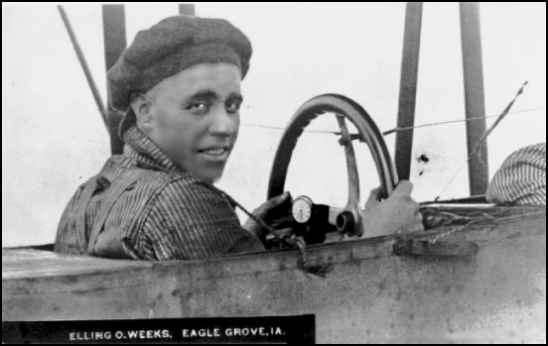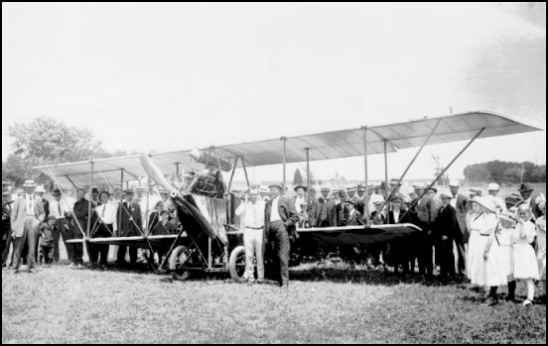
PAGE 2 |
 |
|
Flying was threatening and expensive. Within a handful of flying hours, each airplane was crippled or destroyed, then rebuilt,
scavenged, or salvaged. In their earliest days, standards of safety and quality control were unknown to Chicago's Early Birds. Each of their airplanes was a reeking, oil stained patchwork of doped linen, glued wood joints, flying wires, pulleys, and turnbuckle screws. In order to keep the aircraft flying, Elling Weeks and his friends purchased odds and ends of questionable origin from nearby general stores. Most Early Birds owned pilot license numbers below #99. Because a license was not mandatory to being a pilot, Elling was in no hurry to apply. Two years after his first solo, he earned pilot's license #214. His primary goals were personal high adventure and aviation records. Magazines and newspapers focused on Elling's exploits, much the same as media attention concentrated on the early astronauts. In early 1914, he was the first pilot to carry daily newspapers between cities – the 21,500 yards from Scranton to Carbondale, Pennsylvania. Elling went on to set numerous flight endurance and altitude records during the next several years. And he shared two implausible predictions with newspaper reporters : “ Airplanes will soon be safer than automobiles. And they will be able to carry 500 passengers." His kid brother, my father, helped him build seven innovative aircraft from scratch. In one way or another, each of the aircraft was destroyed. It was so risky, my grandfather forbade Elling's numerous brothers and sisters from accepting his offers of free rides. He didn't want to have two children maimed or killed in the same accident. Dangers were real and appeared quickly from inconceivable directions. |
 |
|
For example, one cold, dry winter day in Pennsylvania, Uncle Elling was preparing for a bomb style delivery of theater tickets
and prizes over a distant fairground. He was so excited about the flight he neglected to cover his face with a chamois mask he'd
designed with eye-slits. Worse, he'd forgotten to place his protective goggles over his eyes. This essential equipment was just inside his coat, squeezed between thick layers of newspapers insulating his body from the cold wind. As it turned out, his goggles could have been a dozen yards away from his hands instead of inches. Shortly after takeoff, the slipstream's icy impact on his naked eyes made him painfully aware of his oversight. Elling moved his gloved hand from the touchy controls to retrieve his goggles. Instantly, the unstable aircraft headed for the ground. He groped for the control sticks, and wrenched the pusher biplane out of its diving turn. His next mistake was identical to a pilot error causing thousands of pilots' deaths in future years. It was show time! An expectant and large crowd was waiting for him. In addition, Elling's debts were past due. And his $500 flight bonus was in jeopardy. Ignoring the accelerating danger and the growing pain in his eyes. He chose to press on. Elling off-loaded the tickets and prizes over a throng of excited people at the fairground, then turned for home. The excitement of his achievement had momentarily drained away the adrenaline masking him from his pain. Elling had blinked his wind-dried eyes, to the point where he severely abraded them. The constant blinking had literally sandpapered the corneas of his eyes. Nearing his home field, he thought to himself, " Man it's cold ! " |


 PAGE 3 PAGE 3
|